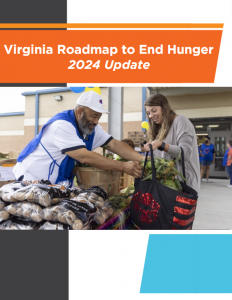Everyone needs nutritious food to thrive. While Virginians are working hard to provide for themselves and their families, approximately 964,000 people—that’s one in 9 Virginians—are still facing hunger. As food prices and household expenses like rent and healthcare remain high, the end of pandemic-era assistance programs adds to challenges. Hunger exists in every community in Virginia, and is often hidden.
- Virginia’s food insecurity rate is 11.1%, meaning 1 in 9 Virginians do not always have enough money or food to make ends meet
- Children experience food insecurity at higher rates (13.6% or about 1 in 7)
- Black and Hispanic households are more than twice as likely to experience food insecurity than white households
- Eight of the 10 localities with the highest rates of food insecurity are rural and are concentrated in the Southwest region
- Hunger is associated with poor health outcomes, and food-insecure individuals pay about $1,500 more on healthcare each year
- While seniors are slightly less likely to face hunger than younger people, only 2 out of 5 eligible seniors are enrolled in SNAP
Virginia’s food banks are stepping up like never before. Together, we served 157 million pounds of groceries in 2023. We advocate for strong anti-hunger policies and work with many partners—from farmers to healthcare providers—to ensure fewer Virginians find themselves in need
>> Read more about Virginia’s comprehensive plan to end hunger.
>> Learn how Virginia’s food banks distribute more than 10 million pounds of food every month.
>> View the Federation of Virginia Food Banks 2024 Impact Report

